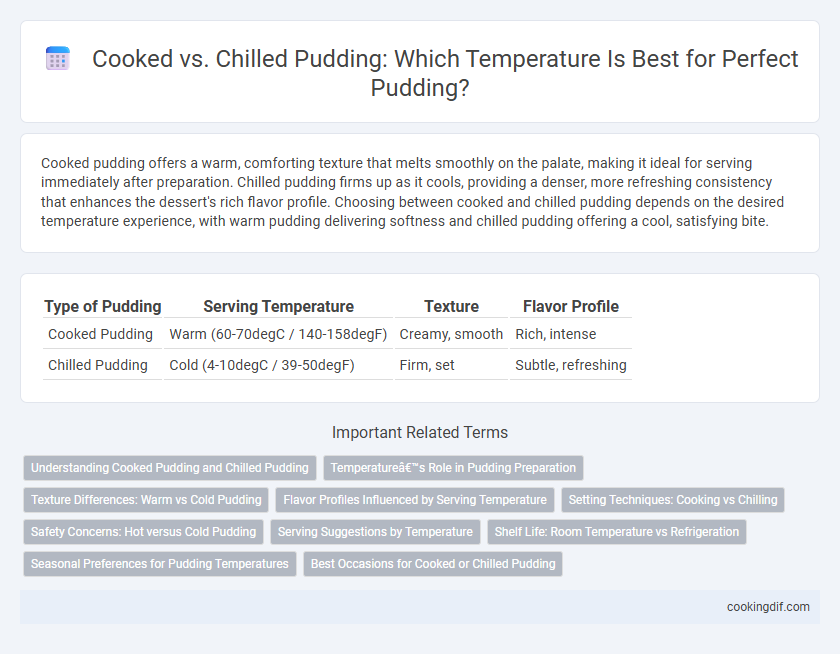Cooked pudding offers a warm, comforting texture that melts smoothly on the palate, making it ideal for serving immediately after preparation. Chilled pudding firms up as it cools, providing a denser, more refreshing consistency that enhances the dessert's rich flavor profile. Choosing between cooked and chilled pudding depends on the desired temperature experience, with warm pudding delivering softness and chilled pudding offering a cool, satisfying bite.
Table of Comparison
| Type of Pudding | Serving Temperature | Texture | Flavor Profile |
|---|---|---|---|
| Cooked Pudding | Warm (60-70degC / 140-158degF) | Creamy, smooth | Rich, intense |
| Chilled Pudding | Cold (4-10degC / 39-50degF) | Firm, set | Subtle, refreshing |
Understanding Cooked Pudding and Chilled Pudding
Cooked pudding typically involves heating ingredients such as milk, sugar, and starch to a specific temperature to achieve a thick, creamy texture through gelatinization. In contrast, chilled pudding requires cooking the mixture first, then cooling it to allow the starch to set firmly, resulting in a denser consistency. Temperature control during cooking and chilling phases is crucial to ensure the desired texture and prevent issues like curdling or excessive firmness.
Temperature’s Role in Pudding Preparation
Cooked pudding relies on precise heat application to activate starch gelatinization and protein coagulation, creating a smooth, creamy texture. Chilled pudding benefits from cold temperature to set and thicken, enhancing firmness and improving flavor integration. Maintaining optimal temperature control during preparation ensures desirable consistency and prevents curdling or graininess.
Texture Differences: Warm vs Cold Pudding
Cooked pudding served warm typically features a smooth, creamy texture with a slight softness that melts in the mouth, enhancing its rich flavor and making it comforting and velvety. Chilled pudding, in contrast, firms up as it cools, resulting in a denser, slightly gelatinous texture that provides a more structured bite and a refreshing mouthfeel. Temperature significantly influences the pudding's viscosity and tactile sensation, with warmth highlighting its silkiness and cold emphasizing its firmness.
Flavor Profiles Influenced by Serving Temperature
Cooked pudding served warm intensifies caramelized sugar and vanilla notes, enhancing a rich, comforting flavor profile. Chilled pudding offers a refreshing texture and suppresses sweetness, highlighting subtle dairy and spice undertones. Temperature directly influences the perception of pudding's sweetness and aroma, making serving temperature critical for optimal flavor experience.
Setting Techniques: Cooking vs Chilling
Cooked pudding sets through the application of heat, which causes starches or proteins to thicken and create a firm texture, while chilled pudding relies on refrigeration to solidify gelatin or dairy-based mixtures without cooking. Temperature control during cooking is critical to prevent curdling or over-thickening, ensuring a smooth consistency, whereas chilling requires sufficient time at low temperatures to allow proper gelation and stabilization. Understanding these setting techniques is essential for achieving the desired texture and firmness in various pudding recipes.
Safety Concerns: Hot versus Cold Pudding
Cooked pudding requires thorough heating to an internal temperature of at least 160degF (71degC) to eliminate harmful bacteria such as Salmonella and Listeria, ensuring safety during consumption. Chilled pudding, often prepared using pasteurized ingredients and stored below 40degF (4degC), minimizes bacterial growth, but must be handled properly to avoid contamination. Improper temperature control in either hot or cold pudding increases the risk of foodborne illnesses, emphasizing the importance of strict temperature management for safe pudding consumption.
Serving Suggestions by Temperature
Cooked pudding served warm enhances its creamy texture and is ideal for comforting desserts like bread puddings or custards. Chilled pudding offers a firmer consistency, perfect for refreshing treats such as chocolate mousse or panna cotta. Serving temperature impacts flavor perception, with warmth intensifying spices and cold temperatures highlighting sweetness.
Shelf Life: Room Temperature vs Refrigeration
Cooked pudding stored at room temperature typically has a shorter shelf life of about 2 hours due to the risk of bacterial growth, while chilling it in the refrigerator extends freshness up to 3-4 days by slowing microbial activity. Refrigerated pudding maintains optimal texture and safety, as lower temperatures inhibit spoilage enzymes and pathogens. Properly sealed containers also help preserve quality and prevent contamination during refrigeration.
Seasonal Preferences for Pudding Temperatures
Cooked pudding retains warmth, making it ideal for colder seasons when a comforting, hot dessert is preferred, while chilled pudding offers a refreshing contrast suited for warmer weather. Seasonal preferences often dictate serving temperature, with cooked puddings favored in fall and winter, and chilled varieties more popular in spring and summer months. Temperature influences texture perception and taste, as heat enhances creamy richness whereas cold settings highlight firmness and cool sweetness.
Best Occasions for Cooked or Chilled Pudding
Cooked pudding, served warm, is ideal for cozy winter evenings and festive holiday dinners due to its comforting texture and rich flavors that intensify with heat. Chilled pudding, with its smooth and refreshing consistency, suits hot summer days, casual gatherings, and elegant brunches, providing a cool and light dessert option. Selecting between cooked or chilled pudding depends on the season and event, maximizing enjoyment through temperature-appropriate serving.
Cooked pudding vs chilled pudding for temperature Infographic

 cookingdif.com
cookingdif.com